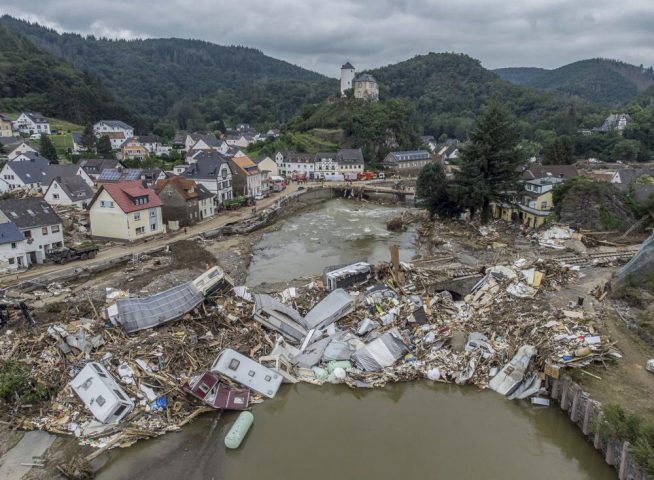German insurers well-positioned for 2021 nat cats: AM Best

By Charlie Wood —Despite the recent widespread and catastrophic flooding across Germany, AM Best believes the country’s non-life segment has, in general, the ability to absorb such high weather-related losses, as it has shown the discipline in the past to price appropriately for such events.
Altenahr, Germany, Monday, July 19, 2021 (Boris Roessler/dpa via AP)
Last week’s flooding impacted parts of Central and Western Europe, including Belgium, the Netherlands, and Switzerland, although Germany remains the worst affected region.
The devastating floods are expected to drive insurance and reinsurance industry losses of between €4 billion and €5 billion.
Before Bernd, the low pressure system which preceded the aforementioned flooding, AM Best highlights two weeks of heavy rain and hail in June caused record levels of insured losses, estimated to be as high as €1.7 billion, with €1 billion of this attributed to property insurance.
Motor insurance accounted for the remaining €700 million in insured losses.
In previous years, benign weather experience contributed to an overall positive result for the German property segment.
Lower than average weather-related claims were reflected in insured property and motor losses in 2020 of €2.5 billion compared with the long-term average of €3.7 billion.
According to German insurance association GDV, more than 90% of residential building insurance policyholders are insured against hail and windstorm, but only 46% have comprehensive cover against elemental perils.
Torrential rain and flood insurance penetration has increased over the past decade from only 19% in 2012. A number of factors have supported this development, including public information and awareness campaigns.
Flood risk is excluded from standard industrial, commercial and homeowner policies, but can be added as an extension (bundled with earthquake, subsidence, landslide, snow pressure and avalanche cover), though often at a high premium.
Unlike fellow European Union member states France and Spain, Germany does not operate a government-backed natural catastrophe insurance scheme. Instead, government participation focuses on prevention and post-event assistance.
In the case of Bernd and its aftermath, the German government is looking to approve a state aid package of up €400 million for immediate use.
Overall, AM Best says 98.5% of natural catastrophes in Germany are insurable, with good quality data and risk mapping available.
Capacity in the domestic market also includes some of the largest re/insurance groups worldwide. This is described as limiting the need for a formalised natural catastrophe scheme.






Leave a Reply